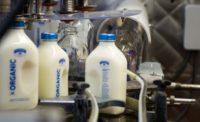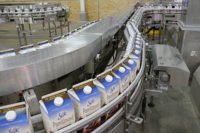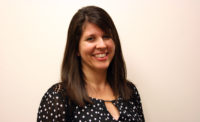Plants of the Future: Bigger, Smarter, More Sustainable
















Refrigerated & Frozen Foods uncovers the latest in green technologies for today’s cold storage distribution and food processing plants.
The next generation of cold storage distribution and food processing plants boasts a future filled with automated equipment, energy efficient construction and new and improved ways of producing and storing cold foods. But, it’s the LED lighting, central refrigeration systems, water conservation efforts and LEED certifications, among other green features, that help design bigger, smarter and more sustainable facilities.
The Future of the Green Building IndustryWhen it comes to plant design, efficiency remains the key component, but the trend is in finding new ways to be efficient in both space and site use, says Jeremy Poling, energy and atmosphere subject matter expert and certification reviewer for U.S. Green Building Council (USGBC), Washington, D.C. “Recovery of waste energy and water are receiving increasing focus in the design of new plants. Manufacturers continue to need new means of reducing costs to stay competitive. Energy and water efficiency are a cost that most owners can exert significant control over,” says Poling. “Alternative refrigerants with low global warming potential are receiving renewed focus from the White House and industry partners. Across Europe, an HFC refrigerant phase-out has begun, and industry partners in the United States have announced significant commitments to reducing HFC use.” Likewise, the focus of the green building industry looks like its switching from new building design and construction to “greening” existing buildings. “The U.S. landscape is covered by more than 60 billion square feet of existing buildings, many of them hogging inordinate amounts of resources and energy due to outdated infrastructure,” Poling adds. “The existing building market represents a much larger opportunity to affect the sustainability of the built environment. Expect more creativity from the design and construction companies for new facilities and renovations to existing facilities. Don’t be afraid to set a high expectation for the operations of new facilities. Even if they cannot reach an 80% reduction in energy use, they may find large energy savings opportunities that had never before been tapped.” Here’s a step-by-step guide on how a cold food processor can “go green:”
Choose next steps for going green that will have big impact/support from within the organization, and that can serve as a guide for continued progress. |
Here’s a breakdown of what some of today’s refrigerated and frozen food processors and distributors are doing to launch their manufacturing plants into the future.
Nestlé USA—making ongoing renovations to existing structures
Nestlé USA, Solon, Ohio, has made several updates to its Dreyer’s Bakersfield, Calif., plant since it was named a Plant of the Future in Refrigerated & Frozen Foods’ April 2008 issue. Some of the most notable changes include replacing the cool strips and door insulation at all entry points to maintain temperature, and replacing approximately 75% of interior HID lights with energy efficient LED lighting.
“Making ongoing renovations to existing structure enables us to leverage the latest and best technology that makes sense for our business, while at the same time, keeping production going and keeping folks in their jobs (vs. completely shutting down for a period of focused renovation),” says Buttons Coleman, factory manager for the Bakersfield ice cream plant. “It also makes sense from a budgeting perspective—we can stay on top of trends and invest accordingly.”
In 2005, the Bakersfield plant underwent a $100 million expansion, and churns out approximately 300 SKUs, up from just 80 SKUs in 2003.
“Making improvements to our product lines as well as making other changes such as overhauling the refrigeration system—replaced evaporator coils, moved valve groups to the roof to gain efficiency and improved safety—we have also been able to improve efficiencies with our business outside the plant,” adds Coleman. “For example, we are more efficient with our distribution with our trucks, reducing our overall carbon footprint. We have also been installing variable frequency drives wherever possible.”
Nestlé also opened the doors to its new Solon, Ohio-based research and development center in August. This $50 million, 144,000-square-foot project, completed by Stellar, Jacksonville, Fla., features a state-of-the-art sensory lab with 15 tasting booths, controlled lighting, high-end presentation kitchens and smaller “pilot plants,” where the latest technologies and recipes are evaluated and refined prior to marketplace introduction.
The center was designed based on an open concept with flexibility to promote collaboration and creativity. For example, large glass curtain walls with metal panels surround the exterior, while the interior features exposed structural elements and mechanical, electrical and plumbing systems. Nestlé R&D Solon is also certified by the Green Building Initiative for Environmental & Energy Efficiency One Green Globe. Green features include drought-tolerant landscaping, low-flow fixtures, recycled materials and emission minimization.
Hormel Foods—exercising continuous improvement
When Hormel Foods’ Progressive Processing facility in Dubuque, Iowa, was built in 2010, it entailed the most efficient lighting system available at that time. Today, a company-wide, plant-wide system captures heat energy, re-uses water and includes landscaping that doesn’t require irrigation.
“We have recently completed upgrades to our refrigeration systems using more efficient equipment and advanced control systems designed to save energy and water at Rochelle Foods, Rochelle, Ill.; Osceola Food, Osceola, Iowa; and Don Miguel Foods, Dallas, Texas,” says Chad Sayles, assistant director of engineering. “We completed a facility expansion in Fremont, Neb., to increase SPAM luncheon meat production and included the same heat recovery and water re-use features that we had applied at Progressive Processing, including heat recovery from the retorts, closed loop cooling and skylights with daylighting controls. We [also] completed renovation projects at our Austin, Minn., and Algona, Iowa, facilities to update our sausage drying processes to include new technology that dries the sausage faster, more consistently and with less energy per pound of product.”
Hormel’s commitment to resource conservation goes beyond its refrigerated foods processing plants.
“We completed a LEED Gold-certified addition to the Hormel Foods world headquarters in Austin, Minn., and a new data center in Blooming Prairie, Minn., that includes a geothermal cooling system, heat recovery ventilation and high-efficiency lighting systems,” adds Sayles.
Furthermore, Hormel uses a process of “recommissioning” to ensure that older systems continue to function as they were designed and to identify opportunities for upgrades that can save energy and water, he adds.
Hormel also approaches each new construction project with a mindset of continuous improvement in design and execution, according to Tom Raymond, director of environmental sustainability.
“For example, we will continue to look for ways to apply improved lighting systems, HVAC and process controls,” he adds. “Heat capture and minimal or non-consumptive water use will also remain on trend and will simply evolve into wider use as technology advances.”
Golden State Foods—working smarter, not harder
When Golden State Foods (GSF) completed its McCook, Ill., distribution center in June 2013, it totaled more than 158,286 square feet, facilitated green and sustainable initiatives and allowed for contingency and long-term capacity. Today, that long-term capacity comes with the implementation of KE2therm technology. Manufactured by KE2 Therm Solutions, Inc., Washington, Mo., KE2therm technology consists of “smart” refrigeration controls for defrosting the evaporator coils used in coolers and freezers.
“Transitioning from traditional mechanical controls, the PLC-based control management provides increased reliability, and more importantly, a precise temperature control, while improving system overall performance,” says Dimetria Jackson, director of corporate social responsibility and sustainability for GSF, Irvine, Calif. “Due to precise temperature controls, the refrigeration equipment endures less wear/tear, utilizes less power by eliminating excessive run cycles and the equipment lasts longer.”
GSF has also embarked upon several sustainability initiatives, including LEED certification, cool roofs, cascade refrigeration systems, harvesting rainwater for landscape irrigation, using FCS-certified wood and high-efficiency plumbing systems and fixtures, adds Jackson. In 2016, GSF is building a LEED-certified manufacturing facility in Opelika, Ala.
“GSF continues to explore the implementation of additional sustainable green building practices, including solar, xeriscaping, water-cooled air conditioning systems, cross-ventilation and stormwater management through the use of green roofs,” Jackson says.
Fresh Express—renovating an existing structure to meet LEED certifications
Fresh Express, a Salinas, Calif.-based subsidiary of Chiquita Brands International Inc., completed a LEED Silver-certified ready-cut food processing facility in Streamwood, Ill. Design-build firm Opus Design Build, LLC, Minneapolis, renovated the existing structure and constructed building additions to create the 335,000-square-foot facility used for food processing, cold storage warehousing and office space.
“Building and material re-use was a major component that led to the [LEED Silver] certification,” says Jim Caesar, regional vice president for Opus. “Much of the material recovered during demolition of a portion of the existing structure was incorporated into the new building. We also focused on selecting and incorporating highly efficient systems into the building. These included creating a highly insulated and efficient building skin—the components that separate the interior and exterior of the building and can play into controlling climate, ventilation and energy consumption, installing high-efficiency ammonia refrigeration systems and office building systems for items such as HVAC and lighting as well as plumbing fixtures with low water use. Additionally, low VOC materials were intentionally used throughout the facility to improve indoor air quality. Fresh Express selected an excellent site to begin their sustainability efforts, as it allowed us to use some of the existing structure that was on the site while improving the lot with additional new construction.”
ALDI—reducing operating costs one energy efficient measure at a time
In October 2014, A M King Co., Charlotte, N.C., partnered with ALDI, Batavia, Ill., to expand two of its regional distribution facilities in Webberville, Mich., and Saxonburg, Pa. Energy efficient features include LED light fixtures with occupancy sensors, insulated rapid bi-parting doors to help minimize air transfer between temperature zones, a single-ply, white PVC roofing membrane over the entire expansion to provide reflectivity and improve energy efficiency and variable frequency drives on new refrigeration equipment and retrofitted onto existing equipment, according to Daniel Crist, vice president of A M King.
“Owners of existing facilities are focused on reducing operating costs,” he adds. “Several expansion and renovation projects completed by A M King incorporated green features that the original facility lacked. Fixture replacement and retrofitting of equipment to improve energy efficiency are common owner requests.”
US Foods—Going Greenfield
Earlier this year, ESI Group USA, Hartland, Wis., completed a Greenfield project for US Foods’ Flowood, Miss., plant, which entailed using oversized condensers and variable frequency drives on compressors and fans to maximize efficiencies, installing a non-chemical water treatment system to reduce water, designing a heat recovery system for pre-heating domestic water and employing reduced foot-candles and florescent and LED light fixtures, occupancy sensors and lighting control systems as well as natural daylighting strategies, among others.
“Many more buildings are retrofitted, expanded and renovated than built new annually, but that doesn’t contain the desire for a ‘green’ building,” says Tim Gibbons, vice president of design and business development for ESI Group. “Many retrofits of existing buildings in the cold storage business are large enough that they must be considered new construction, laying a clearer path to certification. The installation of refrigeration systems, new racking systems leading to new lighting layouts, the internal construction of freezers and coolers and a complete redesign of the office areas to suit the needs of a new operation many times require the building to be considered new.”
OSI Group—exercising environmental responsibility
OSI Food Solutions’ Ostróda, Poland, food processing plant achieved Gold LEED certification by implementing practical and measurable strategies and solutions aimed at achieving high performance in sustainable site development, water savings, energy efficiency, materials selection and indoor environmental quality, says Alison Kovaleski, director, communications and marketing for OSI Group, LLC, Aurora, Ill.
Environmentally responsible and resource-efficient measures include efficient indoor and outdoor LED lighting, renewable energy sources (photovoltaic, wind), above-standard building insulation, chemical-free water treatment system, rain water capture and heat recovery for cleaning water and an energy monitoring system.
Meanwhile, water reduction is a major focus at OSI’s primary processing facility in Alpenrind, Austria. That’s why in late 2014, OSI invested in a new sanitizing system to clean the meat boxes, thus saving 2 liters of water for every box cleaned.
“Today’s consumer is expecting sustainable solutions from the products they buy, and has been shown to be willing to pay extra for those solutions,” says Larry Glaser, assistant vice president/director of operations support. “The trends are driven today by two main factors—the consumer demand for a sustainable story and a positive ROI for the company. With the costs dropping for new technology often used for more sustainable systems, installing such systems is a win-win, satisfying both the consumer and the business.”
Sabra Dipping Co.—promoting healthy, balanced eating through sustainability
Sabra Dipping Co., White Plains, N.Y., has made several updates to its Colonial Heights, Va., hummus plant since it was named a Plant of the Future in Refrigerated & Frozen Foods’ July 2012 issue. For example, in 2014, it expanded the Virginia plant by 115,000 square feet, including a 26,000-square-foot finished goods warehouse expansion. Sustainable features included a roof with white/reflective to reduce energy usage, high-efficiency lighting, skylights and pre-formed concrete panels to reduce time/efficiency in construction, among others.
“One of Sabra’s driving principles is our admiration for the difference between people, cultures and the wish to bring them closer,” says Willie Johnson, director of global engineering.“We promote healthy and balanced eating by providing extraordinary culinary experiences. We are motivated by respect for nature and all the good it provides us. We understand our impact on the world we live in, and therefore, are committed to preserving and safeguarding natural resources.”
Looking for a reprint of this article?
From high-res PDFs to custom plaques, order your copy today!














